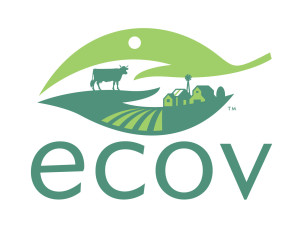
The Appalachian hills provide the setting for an ornate palace dedicated to the great spiritual master who brought love of Krishna to the West.
Prabhupada’s Palace of Gold – Back To Godhead Article – July 1981.
by Yogesvara Dasa
In the Hills of West Virginia
The Appalachian hills provide the setting for an ornate palace dedicated to the great spiritual master who brought love of Krishna to the West.
Just around a bend in the road, crowning a lush green hill surrounded by valleys and forests in the West Virginia panhandle, stands Prabhupada’s Palace of Gold, a handcrafted seven-years-in-the-making miracle of inlaid marble walls and floors, stained-glass windows, crystal chandeliers, and a three-hundred-ton gold-leafed dome that glitters like a second sun. In the words of one commentator for The Today Show, “You won’t believe your eyes.”
How did it get there? Who built it? And why? Such questions never fail to cross the minds of the half million visitors who come from all over the world each year to see ‘The Taj Mahal of the West.” The Palace was built by the devotees of New Vrindaban. the West Virginia farm community of the International Society for Krishna Consciousness (ISKCON). as a memorial to ISKCON’s founder and spiritual guide. His Divine Grace A.C. Bhaktivedanta Swami Prabhupada.
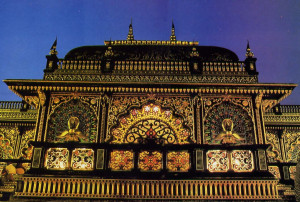
A front view of the Palace reveals some of the 8,000 square feet of 22-karat gold leaf that highlights the building’s surface. Six hundred gilded balusters encircle the Palace at its base.
Apart from its architectural and artistic appeal, the Palace is also a place of worship where devotees of Lord Krsna honor their spiritual master, a lifelong devotee of God, for his work of establishing Krsna consciousness love of God around the world.
How much is the Palace worth? Some experts have guessed 10 to 15 million dollars, but they’re quick to add that such work just isn’t done any more, so an accurate estimate is difficult. So far, the devotees have actually invested only $600,000 for construction materials and equipment. And they did the work themselves.
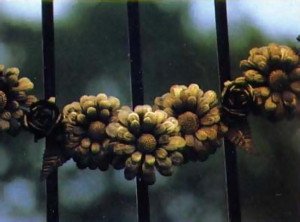
Detail from wrought-iron gates at the Palace shows the skill of devotee craftspeople.
Where did the money come from? During the seven years of construction more than 200 community members and supporters raised it through private donations and from the Palace’s thriving tourism. Also helpful were contributions from the Hindu community (who see Krsna temples as their “home away from home”) and income from commissioned work by devotee artists, such as the mural in Wheeling’s Civic Center, painted by New Vrindaban resident Muralidhara dasa.
The New Vrindaban community was started in 1968, under the direct guidance of Srila Prabhupada. His disciples came to West Virginia to set up a farm that would demonstrate the principles of Krsna conscious life: simple living, based on nature and the cows, balanced by ”high thinking” in short, a life dedicated to the service of God, free from the dependencies of consumer civilization. Such a palace, he hoped, would also be a pilgrimage site, a Western version of Vrndavana, the village in India where Lord Krsna appeared five thousand years ago.
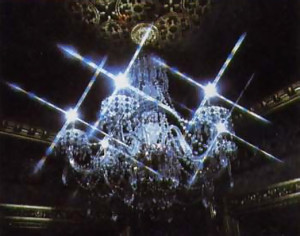
The Taj Mahal of the West gleams with the light of 42 handmade chandeliers.
But how does an elaborate royal palace fit in with such nonmaterialistic aspirations? Devotees explain that simplicity in their own lives does not rule out opulence in the worship of God or His representatives. They also view the Palace as a mark of Krsna culture, where interested people can learn the basic principle spiritual life. And the Palace also serves a place of celebration. Annual festivals draw tens of thousands of pilgrims to attend ceremonies, plays, and feasts cooked in huge kitchens behind the Palace.
In its design the Palace is unique. While most churches and cathedrals reflect orthodox motifs of their culture, the ace is a blending of Eastern and Western styles, as if to say that service to God is the universal principle of all religions. While the Eastern roots of the Krsna consciousness movement can be seen in the intricate latticework, peacock windows, and traditional marble patterns, the movement’s presence in the West is reflected castlelike railings, cathedral-inspired arches, and bright color combinations.
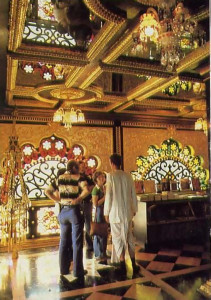
101 mirrors (like those on the ceiling), and more than 12,000 pieces of sculpted. stained, and etched glass fitted into 80 windows. Marble for the floors and walls was imported from various parts or the world.
The Palace actually started out in 1973 to be a simple home for Srila Prabhupada who had come to America eight years earlier, at age sixty-nine, to spread teachings of Lord Krsna. When Prabhupada passed away in 1977, the devotees building it decided to make it into a memorial, and the residents of New Vrindaban set out to transform a home into a palace.
Without any prior training in construction, masonry, or the other skills for such a task, the devotees set to work. Acquiring advice and help along the way, they learned architecture, bricklaying, carpentry, plumbing, electrical work, casting, marble cutting and polishing, stained-glass making, and landscaping. Mothers with their children, men young and old friends and neighbors each person worked in the spirit of Bhagavad-gita, the main text of Krsna devotees:
All that you do, all that you eat, all that you offer and give away, as well as any sacrifice that you may perform, should be done as an offering to Me.
The winters were often bitter cold. Earth turned to mud ankle-deep, and some of the less hardy left the farm in defeat. The work went on, however, fired by Srila Prabhupada’s vision of a holy place in the hills of West Virginia, and the dream slowly became a reality.
A Tour of the Palace
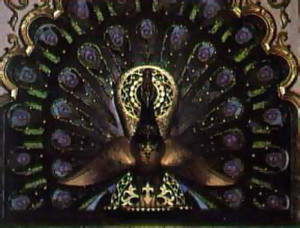
Stained glass peacock windows.
What makes the Palace shine so brightly is its outer covering of 22-karat gold leaf 8,000 square feet of sheets one thousandth of an inch thick, protected by four layers of shellac. Entering the Palace through one of two main doors, we find ourselves beneath an arched ceiling painted as a Himalayan landscape. Devotee artists airbrushed the large areas and then added details by hand. They assembled 11,000 pieces of Austrian crystal to make the forty-two chandeliers that illuminate the main hallway. Each chandelier is color-coordinated to match the stained-glass windows.
For the walls and floors of the Palace, devotees imported forty different kinds of marble and onyx from Italy, France, Turkey, and Brazil. They cut the large raw slabs into more than 20,000 smaller pieces, polished them all, and shaped them into delicate inlaid designs. Then each ensemble was polished and fitted into place. In all, the 35,000 square feet of the Palace display 254 tons of marble.
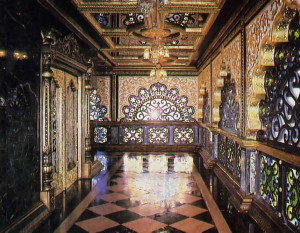
Fine marble inlays show expertise the devotees acquired during the seven years they spent working to build the Palace.
The first room we see down the left hallway is the reception room, with furnishings handcrafted at New Vrindaban’s marble shop. Here we see photo displays of Srila Prabhupada’s worldwide missionary activities. The door is fitted with sand-blasted glass, designed and shaped pieces of glass. Stones from Czechoslovakia further decorate each window. In India, peacocks are regarded as creatures of good fortune, and Lord Krsna is easily recognized by the peacock feather in His hair.
Continuing down the left hallway, we see the kitchen, where devotees cook vegetarian foods according to ancient recipes. The food is prepared six times daily and offered to Srila Prabhupada in the main temple as an act of devotion.
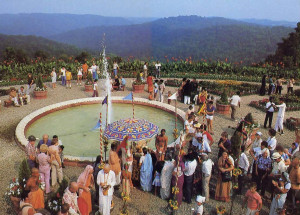
Devotees and guests mingle by a fountain in the Palace gardens. New Vrindaban has begun to reveal itself as a place of pilgrimage in the Western world, a place where people can come and see spiritual life in action.
Once we reach the back hallway, we look out onto twenty acres of sculpted gardens and a terrace that serves as a stage for devotional plays and concerts. The terrace is the roof of an underground mall that houses a restaurant, a museum, a library, and a display area where devotees demonstrate their crafts. Beyond the gardens is a guest pavilion, with a large meeting hall and sixty rooms.
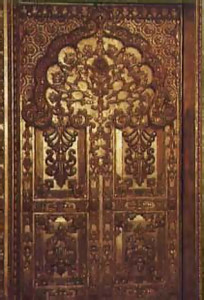
This gold-leafed teakwood door leads to the main hall from Srila Prabhupada’s study.
As we continue around the hallway, we come to the study, where devotees have installed a lifelike form of Srila Prabhupada posed at his work of translating the Sanskrit scriptures of Krsna consciousness into English. In his lifetime Srila Prabhupada published seventy volumes of devotional literature, which universities across the country have acquired as standard reference works. (Srila Prabhupada’s disciples have translated his writings into sixteen languages.) It took devotees more than two years to complete the walls of the study. The teakwood furniture was carved by a devotee family in Bombay. The vases, of ancient Chinese origin, were donated by one of Srila Prabhupada’s disciples, Alfred Ford, the great-grandson of Henry Ford.

In the study itself guests see a molded form of Srila Prabhupada posed at his work of translating the Sanskrit Vedic scriptures into English.
In the next room, Srila Prabhupada’s bedroom, we see walls made of Italian Botticino marble inlaid with onyx. The ceiling was painted by devotees lying on their backs, Michelangelo-style. The nine hundred flowers decorating the walls took a devotee artist four months to paint.

An antique French chandelier lights the ceiling of the main hall of worship. The large mural partially obscured by the chandelier depicts Lord Krsna dancing with the cowherd damsels of Vrndavana. The other large mural shows Lord Caitanya, an incarnation of Krsna, chanting the Hare Krsna mantra and dancing with His close associates.
In the center of the Palace is the main temple. Here daily classes and ceremonies take place, lit by a 150-year-old French chandelier gold-plated by New Vrindaban craftspeople. Paintings on the ceiling depict scenes from the pastimes Lord Krsna performed when He was present on this planet five thousand years ago. The two central paintings show Sri Caitanya Mahaprabhu chanting God’s holy names in India five hundred years ago and Lord Krsna dancing with His most intimate devotees, the cowherd damsels of Vrndavana.
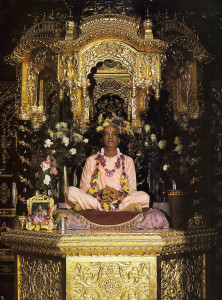
Srila Prabhupada presides over lhe main lemple from a throne of gold and marble. The Palace is to Srila Prabhupada what a beautiful selling is to a diamond.
Adorning the walls of the temple are paintings of the saintly teachers who in recent generations have transmitted the ancient science of Krsna consciousness for the benefit of mankind. Srila Prabhupada, thirty-second in the disciplic line of teachers from Lord Krsna, presides over the temple from a gilded throne beneath a dome of cast gypsum and 4,200 pieces of cut glass.
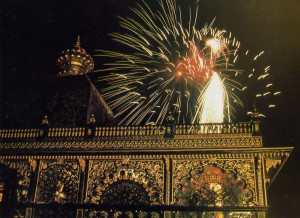
Fireworks fill the night sky during dedication ceremonies for the Palace, in 1980.
 Rotterdam is the second-largest city in the Netherlands and one of the largest ports in the world. Hare Krishna! Jaya Srila Prabhupada.Jaya Sri Sri Gaura-Nitai. -- Read more ›
Rotterdam is the second-largest city in the Netherlands and one of the largest ports in the world. Hare Krishna! Jaya Srila Prabhupada.Jaya Sri Sri Gaura-Nitai. -- Read more ›  Rotterdam is the second-largest city in the Netherlands and one of the largest ports in the world. Hare Krishna! Jaya Srila Prabhupada.Jaya Sri Sri Gaura-Nitai. -- Read more ›
Rotterdam is the second-largest city in the Netherlands and one of the largest ports in the world. Hare Krishna! Jaya Srila Prabhupada.Jaya Sri Sri Gaura-Nitai. -- Read more ›  Saratov, Russia
Saratov, Russia 












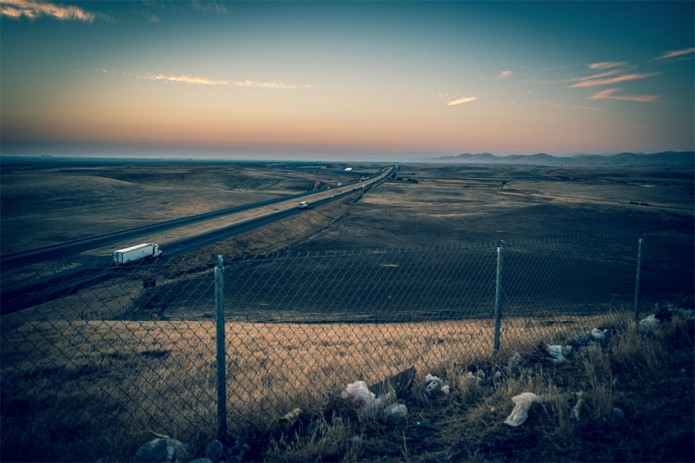

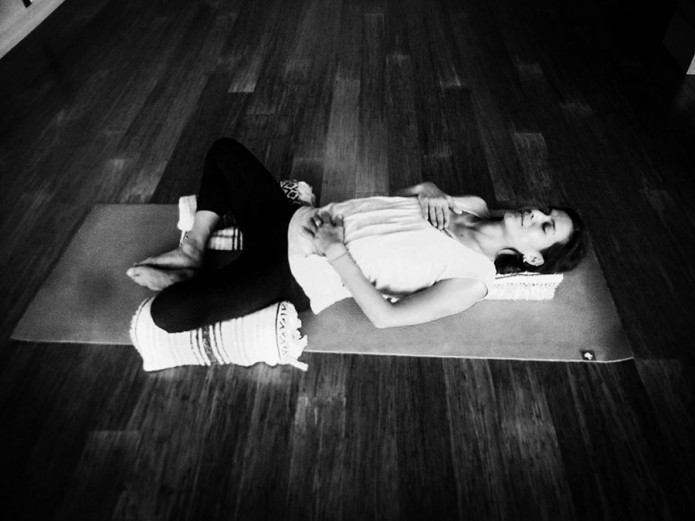
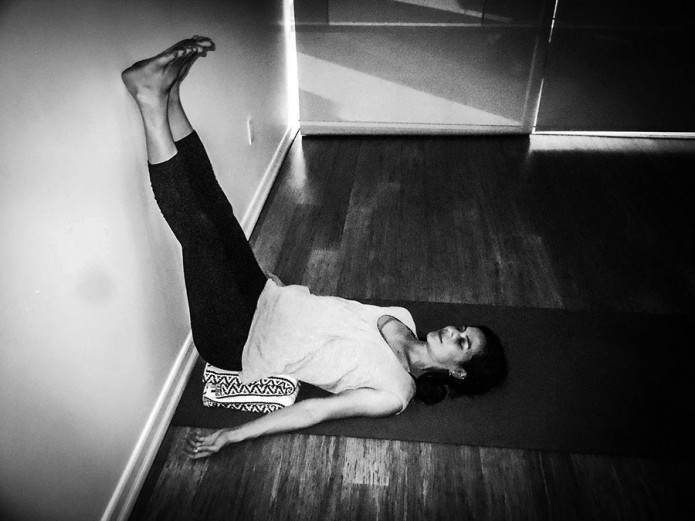
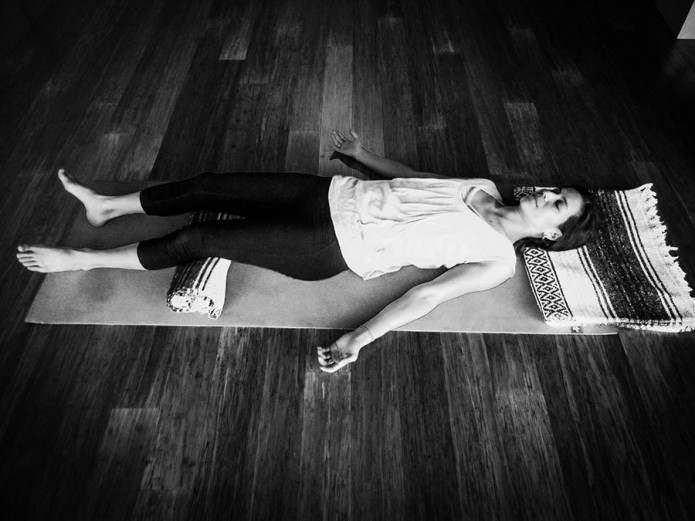

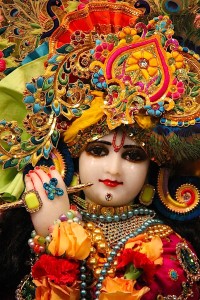
 Iskcon devotees spread the Holy Name
Iskcon devotees spread the Holy Name 
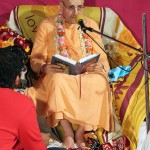
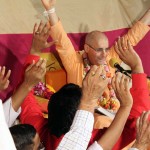

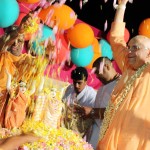

 Byron Bay is a beachside town located in the far-northeastern corner of the state of New South Wales, Australia. It is located 772 kilometres north of Sydney and 165 kilometres south of Brisbane
Byron Bay is a beachside town located in the far-northeastern corner of the state of New South Wales, Australia. It is located 772 kilometres north of Sydney and 165 kilometres south of Brisbane  "Ksira-Chora" means "one who stole sweet condensed milk" and there's a special pastime (see below) about how He received this name. Recently we came across some rare photos of Ksira-Chora Gopinatha in Remuna, normally photography is not permitted so these amazing photos are a rare treat!
"Ksira-Chora" means "one who stole sweet condensed milk" and there's a special pastime (see below) about how He received this name. Recently we came across some rare photos of Ksira-Chora Gopinatha in Remuna, normally photography is not permitted so these amazing photos are a rare treat!  Travel Adventures of a Krishna Monk. Gainesville, Tallahassee, Jacksonville and New York City
Travel Adventures of a Krishna Monk. Gainesville, Tallahassee, Jacksonville and New York City  Festival speakers:
HH Bhakti Bringa Govinda Swami
HH Bhakti Caitanya Swami
HH Niranjana Swami
HH Bhakti Visrambha Madhava Swami
HH Bhakti Sharan Shanta Goswami
HG Dhirasanta Prabhu
HG Nruhari Prabhu
HG Ojasvi Prabhu
Festival speakers:
HH Bhakti Bringa Govinda Swami
HH Bhakti Caitanya Swami
HH Niranjana Swami
HH Bhakti Visrambha Madhava Swami
HH Bhakti Sharan Shanta Goswami
HG Dhirasanta Prabhu
HG Nruhari Prabhu
HG Ojasvi Prabhu 